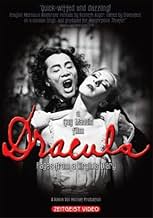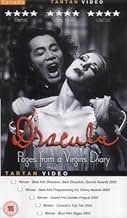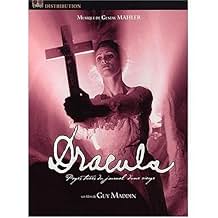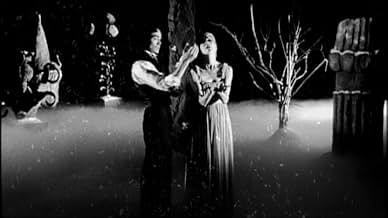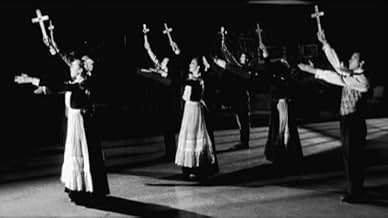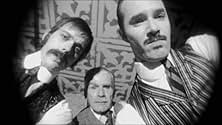Dracula, pages tirées du journal d'une vierge
Titre original : Dracula: Pages from a Virgin's Diary
- 2002
- Tous publics
- 1h 13min
NOTE IMDb
6,8/10
2,3 k
MA NOTE
Ajouter une intrigue dans votre langueA ballet rendition of Bram Stoker's "Dracula", stylized as an Expressionistic silent film.A ballet rendition of Bram Stoker's "Dracula", stylized as an Expressionistic silent film.A ballet rendition of Bram Stoker's "Dracula", stylized as an Expressionistic silent film.
- Réalisation
- Scénario
- Casting principal
- Récompenses
- 4 victoires et 2 nominations au total
Wei-Qiang Zhang
- Dracula
- (as Zhang Wei-Qiang)
Johnny A. Wright
- Jonathon Harker
- (as Johnny Wright)
Avis à la une
Had "Dracula: Pages from a Virgin's Diary" been made in Hollywood of with a huge budget, I don't think I would have been as favorably disposed towards the project. After all, the DVD is a bit rough here and there--credits shake a bit and a few of the computer effects (especially superimpositions) are very rough. BUT, you must realize that this is a production of the Royal Winnepeg Ballet. And, while it's a very well-respected and quality production company, it wasn't like these were seasoned filmmakers. So, I cut it a lot of slack. Based on this, it's actually a rather incredible production--with lovely sets, great costumes and a nice Gothic horror/romantic look about it. Heck, I hate opera and I still appreciated the amazing task they did in creating something like this. Probably not for everyone, but using modern dance and ballet, it does make a sophisticated art form more approachable to the masses.
Lucy Westernra is engaged to marry Lord Arthur Holmwood. However, an evil comes out of the east. She is bitten by Dracula. Vampyr-hunter Abraham Van Helsing arrives to clear out her polluted blood. Mental patient Renfield's escape leads to a massacre. Dracula reanimates Lucy. Van Helsing and the men hunt for Lucy and then finally Dracula himself.
Filmmaker Guy Maddin continues his experimentation. This is mostly black and white with splashes of bright colors. It is a silent film with many of its conventions such as title cards and era appropriate special effects. The ballet dancing can be hypnotic. The story follows the traditional Bram Stoker's Dracula with its xenophobia. It is definitely not for everyone and my fascination with the movie does wear out in the second half. Nevertheless, this is a worthy experiment.
Filmmaker Guy Maddin continues his experimentation. This is mostly black and white with splashes of bright colors. It is a silent film with many of its conventions such as title cards and era appropriate special effects. The ballet dancing can be hypnotic. The story follows the traditional Bram Stoker's Dracula with its xenophobia. It is definitely not for everyone and my fascination with the movie does wear out in the second half. Nevertheless, this is a worthy experiment.
Dracula: Pages from a Virgin's Diary is a silent version of author Bram Stoker's Dracula that also incorporates many ballet-oriented scenes.
My two principle reactions to the film were surprise and delight. I was surprised that the film is so traditional--the silent footage often looks like one is simply watching a film from the 1910s or 1920s. This is heightened by the score, which is extremely conservative, traditional classical music. This surprised me because the Sundance Channel promos for the film kept repeating, ". . . from avant-garde director Guy Maddin". There is not much avant-garde about this film, either in the literal translation of that phrase, as "new wave", or in the more popular sense of "experimental/uncompromisingly different and unusual". Dracula: Pages from a Virgin's Diary is decidedly old wave, and never more experimental, different or unusual than a couple small production design touches that might have been gleaned by anyone who is a big fan of Terry Gilliam's Brazil (1985) and Francis Ford Coppola's Rumble Fish (1983).
Even citing those two influences might be misleading. The Brazil influence is primarily present in a single device--Mrs. Westerna's (Stephanie Ballard) ventilator, and the Rumble Fish influence primarily in the recurrence of red (and occasionally green and gold) within the context of mostly black and white photography (with occasional, very traditional silent film tinting for various scenes). But Dracula: Pages from a Virgin's Diary is so traditional that Maddin frequently even went for German expressionist influenced set design. The sets are wonderful at that, however, and occasional they're more surreal.
It's not that the film is bad for being so traditional, but it took me awhile to adjust my preconceptions, which were misled from the Sundance promo. However, the silent film aspect didn't exactly work well for me, either, and the ballet was a bit blase when it was present, which was less often than I expected. Most of the time I was wondering what the motivation was for the silent film aspect, aside from an exercise in nostalgia and/or cribbing a style of a bygone era, like trying to create a painting that looks almost exactly like Titian, say. On the other hand, it was effective in a couple instances, such as one decapitation-by-shovel (shot from an angle that allowed for minimal gore, to my dismay), where Maddin introduced foley "sound effects" that amped up the impact of the scene. The instances of bright red in the cinematography were also very effective, and not dissimilar to M. Night Shyamalan's The Village (2004), which postdates this film by 2 years.
My delight reaction arose when I realized that much of Dracula: Pages from a Virgin's Diary can be read as an anti-immigration parable. This help explains why Dracula is Chinese here, rather than East European. Under this interpretation, the immigrant Others are invading white Anglo-Saxon shores, usurping authority, "stealing" women and economic power, and so on. It's also notable that Maddin's means of dispatching Dracula in the film is very similar to punishments meted out by Dracula's real-life basis, Vlad Tepes, aka "Vlad the Impaler" (and aka "Dracula" by the way). One popular theory has it that Vlad the Impaler's motivation for his atrocities was primarily to protect the integrity of his Wallachian burg, against what he saw as foreign political and cultural invaders. This makes Dracula's finale in the film fittingly ironic in light of the anti-immigration subtext.
Maddin's film is also interesting for presenting the story in two halves, the first solely centered on Lucy Westerna (Tara Birtwhistle), and the second on Jonathan Harker (Johnny Wright) and Mina (Cindy Marie Small). A pervert rendition of Dr. Van Helsing (Dave Moroni) was also unusual and amusing, but Renfield (Brent Neale) was mostly wasted.
Of course a potential audience for Dracula: Pages from a Virgin's Diary has to be amenable to silent films, and not averse to ballet or traditional classical music. If you fit that bill and you have a taste for horror or an interest in Dracula, this film may be just up your alley.
My two principle reactions to the film were surprise and delight. I was surprised that the film is so traditional--the silent footage often looks like one is simply watching a film from the 1910s or 1920s. This is heightened by the score, which is extremely conservative, traditional classical music. This surprised me because the Sundance Channel promos for the film kept repeating, ". . . from avant-garde director Guy Maddin". There is not much avant-garde about this film, either in the literal translation of that phrase, as "new wave", or in the more popular sense of "experimental/uncompromisingly different and unusual". Dracula: Pages from a Virgin's Diary is decidedly old wave, and never more experimental, different or unusual than a couple small production design touches that might have been gleaned by anyone who is a big fan of Terry Gilliam's Brazil (1985) and Francis Ford Coppola's Rumble Fish (1983).
Even citing those two influences might be misleading. The Brazil influence is primarily present in a single device--Mrs. Westerna's (Stephanie Ballard) ventilator, and the Rumble Fish influence primarily in the recurrence of red (and occasionally green and gold) within the context of mostly black and white photography (with occasional, very traditional silent film tinting for various scenes). But Dracula: Pages from a Virgin's Diary is so traditional that Maddin frequently even went for German expressionist influenced set design. The sets are wonderful at that, however, and occasional they're more surreal.
It's not that the film is bad for being so traditional, but it took me awhile to adjust my preconceptions, which were misled from the Sundance promo. However, the silent film aspect didn't exactly work well for me, either, and the ballet was a bit blase when it was present, which was less often than I expected. Most of the time I was wondering what the motivation was for the silent film aspect, aside from an exercise in nostalgia and/or cribbing a style of a bygone era, like trying to create a painting that looks almost exactly like Titian, say. On the other hand, it was effective in a couple instances, such as one decapitation-by-shovel (shot from an angle that allowed for minimal gore, to my dismay), where Maddin introduced foley "sound effects" that amped up the impact of the scene. The instances of bright red in the cinematography were also very effective, and not dissimilar to M. Night Shyamalan's The Village (2004), which postdates this film by 2 years.
My delight reaction arose when I realized that much of Dracula: Pages from a Virgin's Diary can be read as an anti-immigration parable. This help explains why Dracula is Chinese here, rather than East European. Under this interpretation, the immigrant Others are invading white Anglo-Saxon shores, usurping authority, "stealing" women and economic power, and so on. It's also notable that Maddin's means of dispatching Dracula in the film is very similar to punishments meted out by Dracula's real-life basis, Vlad Tepes, aka "Vlad the Impaler" (and aka "Dracula" by the way). One popular theory has it that Vlad the Impaler's motivation for his atrocities was primarily to protect the integrity of his Wallachian burg, against what he saw as foreign political and cultural invaders. This makes Dracula's finale in the film fittingly ironic in light of the anti-immigration subtext.
Maddin's film is also interesting for presenting the story in two halves, the first solely centered on Lucy Westerna (Tara Birtwhistle), and the second on Jonathan Harker (Johnny Wright) and Mina (Cindy Marie Small). A pervert rendition of Dr. Van Helsing (Dave Moroni) was also unusual and amusing, but Renfield (Brent Neale) was mostly wasted.
Of course a potential audience for Dracula: Pages from a Virgin's Diary has to be amenable to silent films, and not averse to ballet or traditional classical music. If you fit that bill and you have a taste for horror or an interest in Dracula, this film may be just up your alley.
What an absolute thrill, from start to finish, just experiencing the `artistic conception' of this reverent homage to silent film, featuring Canada's Royal Winnipeg Ballet, a stunning performance by Zhang Wei-Qiang as Dracula, and the brilliant production design of Deanne Rohde. Once again, Guy Maddin has created a unique, conceptualized universe all his own; there's nothing else in cinema quite like his eerie, dreamlike imagery. This film is immersed in the thundering power of Mahler's `Resurrection' 2nd Symphony, a work which itself features an ascension from all things human and earthly, and rises into the glorious heavens, a transcendent experience which, musically, grounds this film. From this theme, we add vampires, whose lust for blood promises life everlasting. The performance of Zhang Wei-Qiang dominates throughout, as he is easily the most fascinating stage personality, filled with a mesmerizing ability to seduce and ultimately possess his willing screen sirens, and while I can't speak for anyone else, I always root for him against his puritanesque nemesis, Dr Van Helsing, the leader of the repressed gang of vampire slayers. Ballet director Mark Godden choreographed the ballet adapted by Maddin for this film, so there is constant motion on screen. All this is done in image and in dance, with exaggerated gestures and with an extreme grace in movements, magnificently sensuous and macabre, shrouded in fog and black and white shadows, with only the tiniest color tints. Each frame, by itself, is a still masterpiece; the imagery is that overpowering. But when put in motion by such gifted hands as Maddin's, the film experience is indescribable, but unforgettable.
I really had no idea what to expect coming into this film. I had heard basically nothing about it other than it's good ratings, recommendation from Ebert, and I have been interested for a while now in Guy Maddin. This is my first time watching one of his films and I am borderline speechless. I didn't know he primarily works in the silent genre and to top that, this film is entirely a ballet. Filmed in mostly black and white with silent era techniques, Maddin creates and eerie mood with this take on Brom Stoker's classic novel. I've never seen anything quite like it. It sometimes looks like it from the silent era. It's impressive. My one complaint is the jumpy nature of the camera. I was sometimes focused on his dizzying camera work than what was going on, but still a very refreshing and awakening experience.
Le saviez-vous
- AnecdotesSarah Murphy-Dyson's debut.
- ConnexionsReferenced in Guy Maddin: Son Winnipeg (2014)
- Bandes originalesSymphony #1 (excerpts)
By Gustav Mahler
Meilleurs choix
Connectez-vous pour évaluer et suivre la liste de favoris afin de recevoir des recommandations personnalisées
- How long is Dracula: Pages from a Virgin's Diary?Alimenté par Alexa
Détails
- Date de sortie
- Pays d’origine
- Site officiel
- Langue
- Aussi connu sous le nom de
- Dracula: Pages from a Virgin's Diary
- Lieux de tournage
- Sociétés de production
- Voir plus de crédits d'entreprise sur IMDbPro
Box-office
- Budget
- 1 600 000 $US (estimé)
- Montant brut aux États-Unis et au Canada
- 55 365 $US
- Week-end de sortie aux États-Unis et au Canada
- 4 784 $US
- 18 mai 2003
- Montant brut mondial
- 55 365 $US
- Durée
- 1h 13min(73 min)
- Couleur
- Mixage
- Rapport de forme
- 1.85 : 1
Contribuer à cette page
Suggérer une modification ou ajouter du contenu manquant

